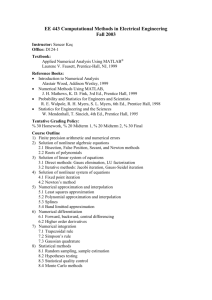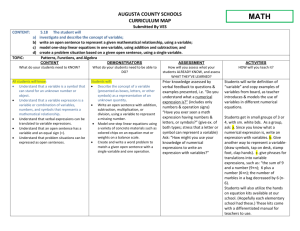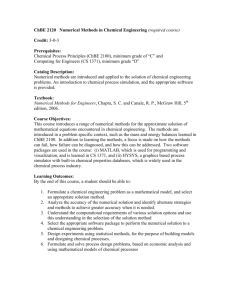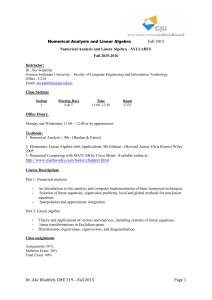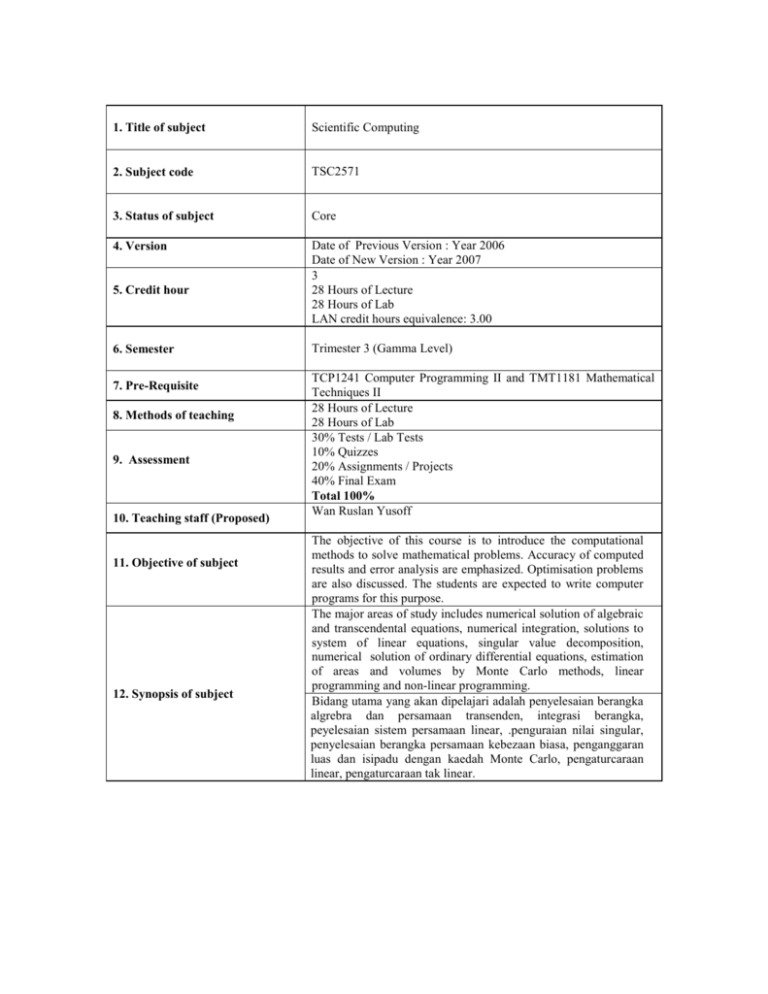
1. Title of subject
Scientific Computing
2. Subject code
TSC2571
3. Status of subject
Core
4. Version
Date of Previous Version : Year 2006
Date of New Version : Year 2007
3
28 Hours of Lecture
28 Hours of Lab
LAN credit hours equivalence: 3.00
5. Credit hour
6. Semester
7. Pre-Requisite
8. Methods of teaching
9. Assessment
10. Teaching staff (Proposed)
11. Objective of subject
12. Synopsis of subject
Trimester 3 (Gamma Level)
TCP1241 Computer Programming II and TMT1181 Mathematical
Techniques II
28 Hours of Lecture
28 Hours of Lab
30% Tests / Lab Tests
10% Quizzes
20% Assignments / Projects
40% Final Exam
Total 100%
Wan Ruslan Yusoff
The objective of this course is to introduce the computational
methods to solve mathematical problems. Accuracy of computed
results and error analysis are emphasized. Optimisation problems
are also discussed. The students are expected to write computer
programs for this purpose.
The major areas of study includes numerical solution of algebraic
and transcendental equations, numerical integration, solutions to
system of linear equations, singular value decomposition,
numerical solution of ordinary differential equations, estimation
of areas and volumes by Monte Carlo methods, linear
programming and non-linear programming.
Bidang utama yang akan dipelajari adalah penyelesaian berangka
algrebra dan persamaan transenden, integrasi berangka,
peyelesaian sistem persamaan linear, .penguraian nilai singular,
penyelesaian berangka persamaan kebezaan biasa, penganggaran
luas dan isipadu dengan kaedah Monte Carlo, pengaturcaraan
linear, pengaturcaraan tak linear.
By the end of the subject, students should be able to:
Identify and apply the algorithms needed to solve a
particular numerical problem.
Identify the advantages and disadvantages of the various
numerical algorithms to solve scientific computation
problems.
Program the various algorithms in a programming
language.
Analyze and estimate the time efficiency of the various
algorithms.
Describe and interpret and analyze the errors and the
accuracy of the various algorithms
Programme Outcomes
% of
contribution
5
Ability to apply soft skills in work and career
related activities
30
Good understanding of fundamental concepts
20
Acquisition and mastery of knowledge in
specialized area
13. Learning Outcomes
14. Details of subject
Acquisition of analytical capabilities and problem
solving skills
30
Adaptability and passion for learning
5
Cultivation of innovative mind and development
of entrepreneurial
skills
5
Understanding of the responsibility with moral
and professional ethics
5
Topics Covered
1.
2.
3.
Introduction
Nested Multiplication, Errors: Absolute and
Relative, Rounding and Chopping, Review of
Taylor Series, Number Representations and
Error, Loss of Significance.
Solution of Algebraic and Transcendental
Equations
Bisection method: Bisection Algorithm and
Pseudo-code, Newton`s Method, System of
Nonlinear Equations, Secant Method,
Convergence Analysis.
Numerical Integration
Definite Integral, Riemann-Integrable Functions,
Trapezoidal Rule, Error Analysis, Recursive
Trapezoidal Formula for 2n Equal Subintervals,
Romberg Algorithm, Adaptive Simpson`s
Scheme, Gaussian Quadrature Formulas.
Hours
2
2
3
4.
5.
6.
7.
8.
15. Laboratory
16. Text
Systems of Linear Equations
Naïve Gauss Elimination, Condition Number and
Ill-Conditioning, Residual and Error Vectors,
Gauss Elimination with Scaled Partial Pivoting,
Tridiagonal and Banded Systems, LU
Factorization, Multiple Right-Hand Sides,
Computing A-1, Singular Value Decomposition,
Iterative solution of Linear Equations,
Convergence Analysis.
Ordinary Differential Equations
Taylor Series Method, Types of Errors, RungeKutta Methods of Order 2 and 4, Stability and
Adaptive Runge-Kutta and Multi-Step Methods.
Monte Carlo Methods and Simulation
Random Number Algorithms/Generators, uses of
Pseudo-random Numbers, Estimation of Areas
and Volumes by Monte Carlo Techniques,
Example of Simulations.
Constrained Optimization
Introduction to Linear Programming, Simplex
Algorithm, Big-M Method, Two-Phase Simplex
Method, Nonlinear Constrained Optimization,
Lagrange Multiplier Method.
Unconstrained Optimization
Golden Section Search Algorithm, Quadratic
Interpolation Algorithm, Gradient Vector and
Hessian Matrix, Steepest Descent Procedure.
Students are expected to implement the
algorithms using a programming language such
as C/C++ or Java in the labs.
Total Contact Hours
Textbook
5
2
2
7
5
28
28
1.
Ward Cheney, David Kincaid,
"Numerical Mathematics and
Computing", Thomson Learning,
2007.
1.
Curtis F. Gerald, Patrick O.
Wheatley, "Applied Numerical
Analysis", Pearson Addison Wesley,
7th Ed., 2003.
Wayne Winston, "Introduction to
Mathematical
Programming
",
Thomson Learning, 3rd Ed, 2002.
William H, " Numerical Recipes in
C++: the art of Scientific
Computing" Cambridge University
Press, 2002.
Michael T. Heath, " Scientific
Computing", McGraw -Hill, 2002.
References
2.
3.
4.




